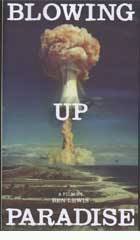
Blowing up Paradise 2005
Distributed by First Run/Icarus Films, 32 Court St., 21st Floor, Brooklyn, NY 11201; 800-876-1710
Produced by Ben Lewis
Directed by Ben Lewis
VHS, color and b&, 60 min.
Sr. High - Adult
Environmental Studies, Ethics, European Studies, Geography, Human Rights, Technology
Date Entered: 09/29/2006
Reviewed by Linda Alkana, Department of History, California State University Long BeachThe filmmakers of Blowing Up Paradise begin their film with a visual contrast: black and white newsreel footage reveals French President Charles DeGaulle proclaiming that France is in danger and needs to “acquire the most powerful weapon of the age,” while juxtaposed color footage shows the preparation and detonation of France’s first nuclear test in the Polynesian Islands in 1966. This test occurred three years after the U.S. and Great Britain had switched to underground testing.
These images set the tone of this remarkable documentary, which traces thirty years of French nuclear tests from 1966-1995 in and around the Moruroa Atoll in French Polynesia. Through the use of commentary by former and current participants and observers of these tests—Polynesians, French government officials, scientists, and peace and environmental activists—the film reveals the determination of the French government to develop a nuclear program, despite increasing global opposition. French politicians and scientists are by turn arrogant and defensive as they face charges of insensitivity to the Polynesians, whose lives and way of life are endangered by the tests. The film also reveals attempts by France to conceal evidence of contamination in Moruroa. This secrecy is also witnessed in France’s attempts to stop the protests. For example, as part of a secret mission, French operatives blew up Greenpeace’s vessel Rainbow Warrior, killing a volunteer. New Zealand police apprehended the French operatives, and the film reveals the French Secret Service concerned more about France’s image, than admitting to the multiple consequences—social, environmental and political—that the French nuclear program is engendering.
The Polynesian Islanders initially supported the program, as they had supported France in World Wars I and II. However, after suffering health effects from the tests and watching their way of life change, some fought back in an attempt at independence from France. After a violent incident, the filmmakers identify some of the Polynesians who fought back as “the first anti-nuclear terrorist group.”
By the mid 1990s, after France had completed its tests and signed the Comprehensive Test Ban Treaty, Moruroa Atoll had undergone detrimental social transformation, with much of the area still a militarized zone, and experts warning of future environmental disaster as a result of the tests.
Despite what some might construe as an anti-French political stance in this documentary, it is far more instructive than polemical. There is a good balance between early and modern footage, and contemporary and current commentary. The people interviewed are all credible. The production value is good; the film is in English and French with English subtitles. It would be a good fit for both public and university libraries.